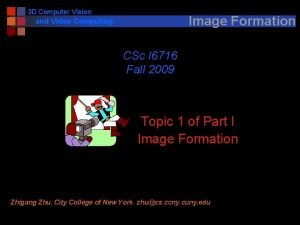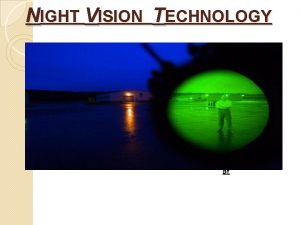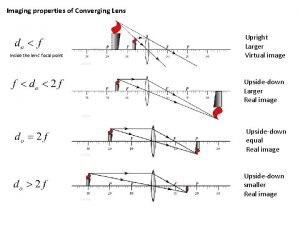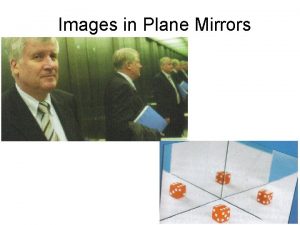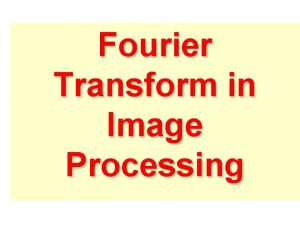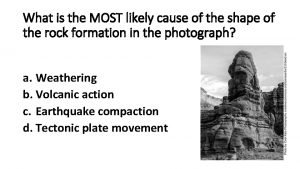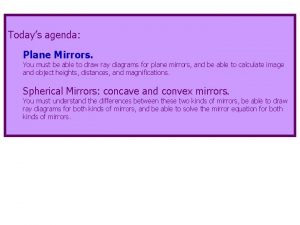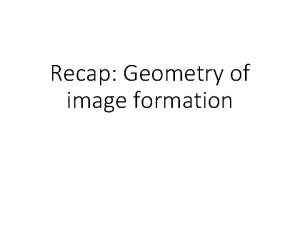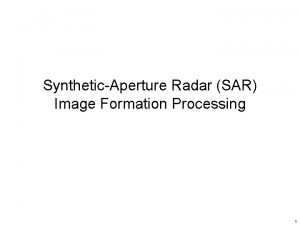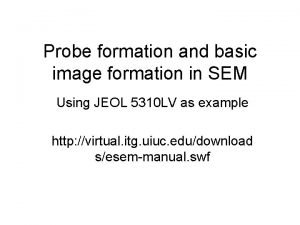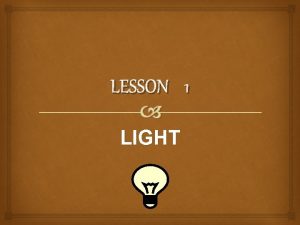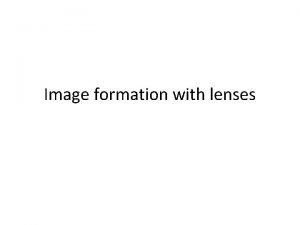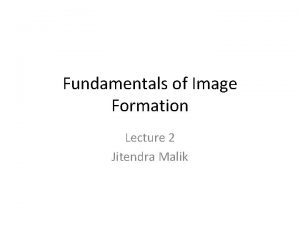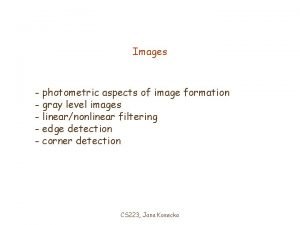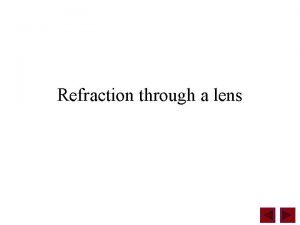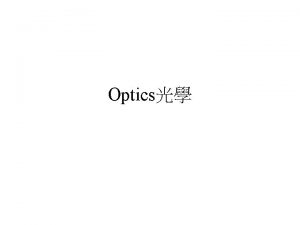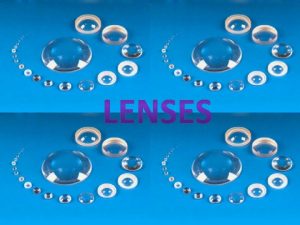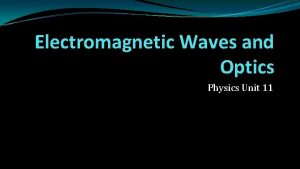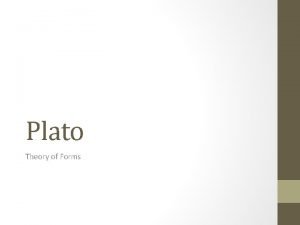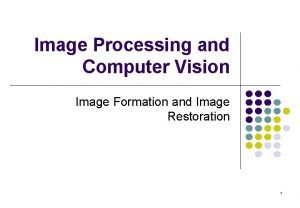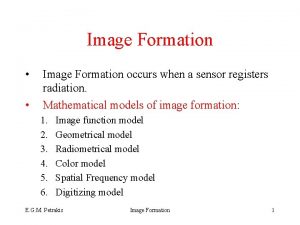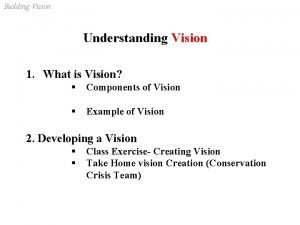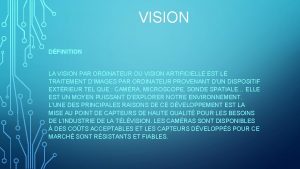Image formation Image Formation Vision infers world properties













































- Slides: 45

Image formation

Image Formation • Vision infers world properties form images. • How do images depend on these properties? • Two key elements • Geometry • Radiometry • We consider only simple models of these

Let’s design a camera • Idea 1: put a piece of film in front of an object • Do we get a reasonable image? Slide by Steve Seitz Pinhole camera • Add a barrier to block off most of the rays – This reduces blurring – The opening is known as the aperture Slide by Steve Seitz

Camera Obscura "When images of illuminated objects. . . penetrate through a small hole into a very dark room. . . you will see [on the opposite wall] these objects in their proper form and color, reduced in size. . . in a reversed position, owing to the intersection of the rays". Da Vinci http: //www. acmi. net. au/AIC/CAMERA_OBSCURA. html (Russell Naughton)

• Used to observe eclipses (eg. , Bacon, 1214 -1294) • By artists (eg. , Vermeer).

Jetty at Margate England, 1898. http: //brightbytes. com/cosite/collection 2. html (Jack and Beverly Wilgus)

Cameras • First photograph due to Niepce • First on record shown in the book - 1822

Pinhole cameras • Abstract camera model - box with a small hole in it • Pinhole cameras work in practice (Forsyth & Ponce)

Distant objects are smaller (Forsyth & Ponce)

Parallel lines meet Common to draw image plane in front of the focal point. Moving the image plane merely scales the image. (Forsyth & Ponce)

Vanishing points • Each set of parallel lines meets at a different point – The vanishing point for this direction • Sets of parallel lines on the same plane lead to collinear vanishing points. – The line is called the horizon for that plane

Properties of Projection • Points project to points • Lines project to lines • Planes project to the whole image or a half image • Angles are not preserved • Degenerate cases • Line through focal point projects to a point. • Plane through focal point projects to line • Plane perpendicular to image plane projects to part of the image (with horizon).

Take out paper and pencil

http: //www. sanford-artedventures. com/create/tech_1 pt_perspective. html

The equation of projection (Forsyth & Ponce)

The equation of projection • Cartesian coordinates: – We have, by similar triangles, that – Ignore third coordinate, and get

Orthographic projection

Weak perspective (scaled orthographic projection) • Issue – perspective effects, but not over the scale of individual objects – collect points into a group at about the same depth, then divide each point by the depth of its group (Forsyth & Ponce)

The Equation of Weak Perspective • s is constant for all points. • Parallel lines no longer converge, they remain parallel.

Pros and Cons of These Models • Weak perspective much simpler math. • Accurate when object is small and distant. • Most useful for recognition. • Pinhole perspective much more accurate for scenes. • Used in structure from motion. • When accuracy really matters, must model real cameras.

Cameras with Lenses (Forsyth & Ponce)

Shrinking the aperture

Interaction of light with matter • Absorption • Scattering • Refraction • Reflection • Other effects: • Diffraction: deviation of straight propagation in the presence of obstacles • Fluorescence: absorbtion of light of a given wavelength by a fluorescent molecule causes reemission at another wavelength


Refraction n 1, n 2: indexes of refraction

Focus and Defocus “circle of confusion” A lens focuses light onto the film • There is a specific distance at which objects are “in focus” – other points project to a “circle of confusion” in the image • Changing the shape of the lens changes this distance Slide by Steve Seitz

Lenses F optical center (Center Of Projection) focal point • A lens focuses parallel rays onto a single focal point • focal point at a distance f beyond the plane of the lens • f is a function of the shape and index of refraction of the lens • Aperture of diameter D restricts the range of rays • aperture may be on either side of the lens • Lenses are typically spherical (easier to produce) • Real cameras use many lenses together (to correct for aberrations)


Assumptions for thin lens equation • Lens surfaces are spherical • Incoming light rays make a small angle with the optical axis • The lens thickness is small compared to the radii of curvature • The refractive index is the same for the media on both sides of the lens

Depth of Field http: //www. cambridgeincolour. com/tutorials/depth-of-field. htm

Aperture controls Depth of Field Changing the aperture size affects depth of field • A smaller aperture increases the range in which the object is approximately in focus • But small aperture reduces amount of light – need to increase exposure

F-number: focal length / aperture diameter

FOV depends of Focal Length f Smaller FOV = larger Focal Length


Field of View / Focal Length Large FOV, small f Camera close to car Small FOV, large f Camera far from the car

Focal length / distance in portraiture

Exposure: shutter speed vs. aperture


Fun with slow shutter speeds Photos by Fredo Durand


Other aberrations • Astigmatism: unevenness of the cornea • Distortion : different areas of lens have different focal length • Coma : point not on optical axis is depicted as asymmetrical cometshaped blob • Chromatic aberration


Chromatic Aberration Slide by Carl Doersch

Radial Distortion (e. g. ‘Barrel’ and ‘pin-cushion’) straight lines curve around the image center

Radial Distortion No distortion Pin cushion Barrel Radial distortion of the image • Caused by imperfect lenses • Deviations are most noticeable for rays that pass through the edge of the lens
 Image formation computer vision
Image formation computer vision Zooming and shrinking in digital image processing
Zooming and shrinking in digital image processing Human vision vs computer vision
Human vision vs computer vision Extensive properties and intensive properties
Extensive properties and intensive properties Physical properties and chemical properties
Physical properties and chemical properties Formation initiale vs formation continue
Formation initiale vs formation continue 30 hr famine world vision
30 hr famine world vision Last mile mobile solutions
Last mile mobile solutions World report on vision
World report on vision Image enhancement in night vision technology
Image enhancement in night vision technology Font detector
Font detector Ezekiel 1 vision image
Ezekiel 1 vision image Properties of a lens
Properties of a lens Properties of plane mirrors
Properties of plane mirrors Fourier image processing
Fourier image processing The most likely cause
The most likely cause Formation of image of an extended object by a plane mirror
Formation of image of an extended object by a plane mirror Geometry of image formation
Geometry of image formation Formation of latent image in radiography
Formation of latent image in radiography Mri image formation
Mri image formation Jacobs cameras
Jacobs cameras Image formation by convex lens
Image formation by convex lens A model of destination image formation
A model of destination image formation Gurney mott theory
Gurney mott theory Geometric and photometric image formation
Geometric and photometric image formation Sar image formation
Sar image formation Digitize jeol sem
Digitize jeol sem Formation of image through narrow holes
Formation of image through narrow holes The principle involved in the image formation by lenses
The principle involved in the image formation by lenses Image formation outline
Image formation outline Fundamentals of image formation
Fundamentals of image formation Photometric image formation
Photometric image formation Fundamentals of image formation
Fundamentals of image formation Perspective projection
Perspective projection What is lens
What is lens Microscope convex or concave
Microscope convex or concave Photographic enlarger ray diagram
Photographic enlarger ray diagram Retina image formation
Retina image formation Physics 11-06 image formation by mirrors
Physics 11-06 image formation by mirrors Opposable thumb primates
Opposable thumb primates Coffee new world or old world
Coffee new world or old world Real world vs digital world
Real world vs digital world What is
What is Ap world history chapter 25 africa and the atlantic world
Ap world history chapter 25 africa and the atlantic world The changing world output and world trade picture
The changing world output and world trade picture Dangerous world tour history world tour - hockenheimring
Dangerous world tour history world tour - hockenheimring
